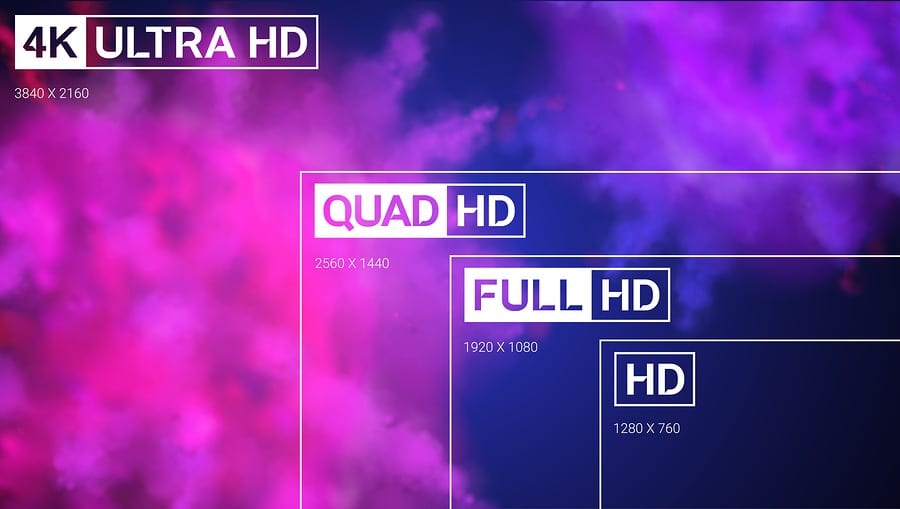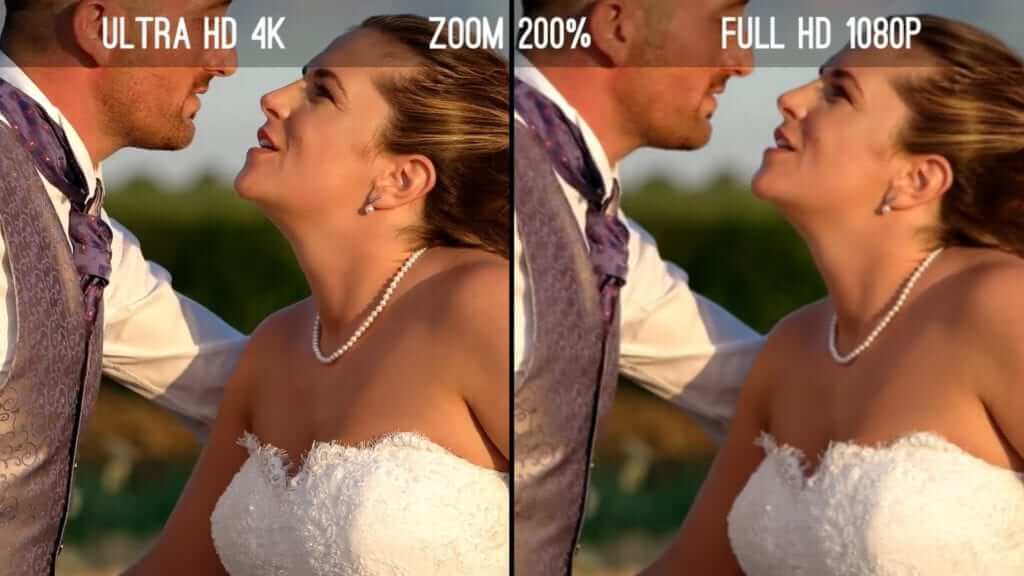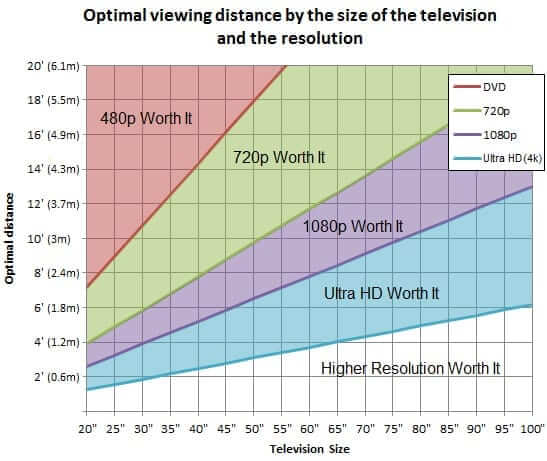These days, 4K TVs are more popular than older 1080p TVs. While 4K TVs might have better resolution and brighter colors, they are also more expensive and offer less content than 1080p TVs. So, is buying a 4K TV really worth it for you? Here’s everything you need to know about what 1080p is, what 4K is, and the difference between 4K vs 1080p.
What Is Screen Resolution?
Resolution is a term that refers to the total number of pixels that a screen can display. It is typically measured in the number of horizontal pixels by vertical pixels. TVs with higher resolutions will usually have sharper images, more vivid colors, and deeper blacks.
Every flat-screen TV is made up of a grid of tiny pixels. Each of these pixels can light up in different colors. If you stand close enough to your screen, you will be able to see individual pixels. Then, when you stand back, the pixels will come together to form an image.

The most common TV resolutions these days are 1280×720 (also known as 720p or HD), 1920×1080 (also known as 1080p or Full HD), and 4K (also known as 2160p or Ultra HD).

However, it is important to keep in mind that a higher resolution won’t necessarily give you a better image. If you want the best picture quality and color contrast, you should also consider the pixel density of your TV, or the number of pixels per inch (PPI). A higher PPI means there will be more detail and dynamic color range on the screen.
What Is 1080p?
A 1080p display resolution has 1,080 vertical pixels and 1,920 horizontal pixels, for a total of roughly 2 million pixels. The “p” in 1080p stands for “progressive scanning,” which means the image is transmitted all at once, as opposed to interlaced scanning.
With interlaced scanning, images are split into even and odd rows. So, a 1080i TV will only display half the image at once, but it switches between the two halves of the image so quickly that it’s hard to see. However, that means 1080i TVs might show some flickering during motion. One the other hand, progressive scanning displays the entire image on every frame at once. This means 1080p TVs offer a much cleaner image, especially when it comes to motion.

These days, interlaced scanning is not very popular, and it is usually only found in old-school CRT and plasma TVs.
What Is 4K?
When talking about TV resolutions, a 4K display has 3,840 pixels horizontally and 2,160 pixels vertically, for a total of roughly 8.3 million pixels. The “K” in 4K stands for kilo (1,000), and it refers to the 4,000 horizontal pixels on the screen.
4K vs 1080p
When comparing 4K vs 1080p, there is no question that 4K TVs offer better image quality. This is because 4K TVs have four times as many pixels as 1080p TVs. However, 1080p TVs are much cheaper and offer a better selection of content.
1. Resolution
Since 4K TVs have so many more pixels than 1080p TVs, you will be able to see more details, the colors will be more vivid, and blacks will be deeper. However, you won’t notice a difference unless you have a large TV, and you are sitting close enough to the screen.

In the image above, you can see the difference between 4K and 1080p when you look at the pattern on the man’s vest and the frills on the woman’s dress. However, if you stand far enough away from your screen, you won’t notice as much of a difference.
2. Content
When it comes to the amount of content available in 4K vs 1080p, there’s still a lot more to watch in Full HD. However, there are hundreds of 4K movies and TV shows on Netflix, Amazon Prime Video, YouTube TV, and other streaming services now.
It is also important to keep in mind that 4K content will have larger file sizes, so it is recommended to have an internet speed of at least 25 Mbps to stream 4K content.
If you want to find out how fast your internet connection is, check out our article on how to do a WiFi speed test.
3. Availability
When it comes to the availability of 4K TVs vs 1080p TVs, things are starting to shift. In 2019, 4K TVs became more popular than 1080p TVs in the US, according to Statista. Now that 4K is the norm, it is harder to find a 1080p TV anymore.
If you find a 1080p TV online now, you should expect that there is a limited stock remaining.
4. Cost
As you might expect, 4K TVs are usually much more expensive than 1080p TVs of the same size. For example, a 49-inch 1080p TV from TCL currently costs about $250, while a 4K TV from the same brand will cost you around $435.
However, most 4K TVs will cost a lot more than $400, and you should expect to pay upwards of $1,000 or more on a new model. If you’re in the market for a new TV, check out our list of the best 4K TVs for 2020 here.
5. Colors
When comparing the color quality of 4K vs 1080p, Ultra HD TVs win by a long shot. Since 4K TVs have a higher resolution, they can render more dynamic colors than 1080p TVs. This means there are more subpixels that can display more hues and shades.
In addition, screen technologies, like liquid crystal display (LCD) and organic light-emitting diode (OLED), can control the amount of light for each pixel, which will give you even more realistic colors and darker blacks.
Is 4K Worth It?
A 4K TV is only worth it if you have a large enough TV, and you are sitting close enough to your screen. According to the Society of Motion Picture and Television Engineers, you would need to be sitting less than eight feet from a 65-inch TV to notice the difference between 4K and 1080p.

That means a 4K TV might not be worth it if you plan on buying a smaller TV or you plan on sitting farther away from the screen. However, these are just general guidelines, and you might be able to notice a difference from a greater distance if you have good eyes.
Also, a 4K TV might not be worth it if you plan on streaming content and you have an internet speed slower than 25 Mbps.
Finally, most of the latest smart TV features are only coming to newer 4K TVs. While 1080p TVs are about as good as they are going to get, a 4K TV can now offer excellent value for your money and is a great investment for future-proofing your home or office entertainment.
After deciding between 4K vs 1080p, you might want to get a streaming device to get the most out of your new TV. Take our short quiz to find the best streaming device for you.
HelloTech editors choose the products and services we write about. When you buy through our links, we may earn a commission.



